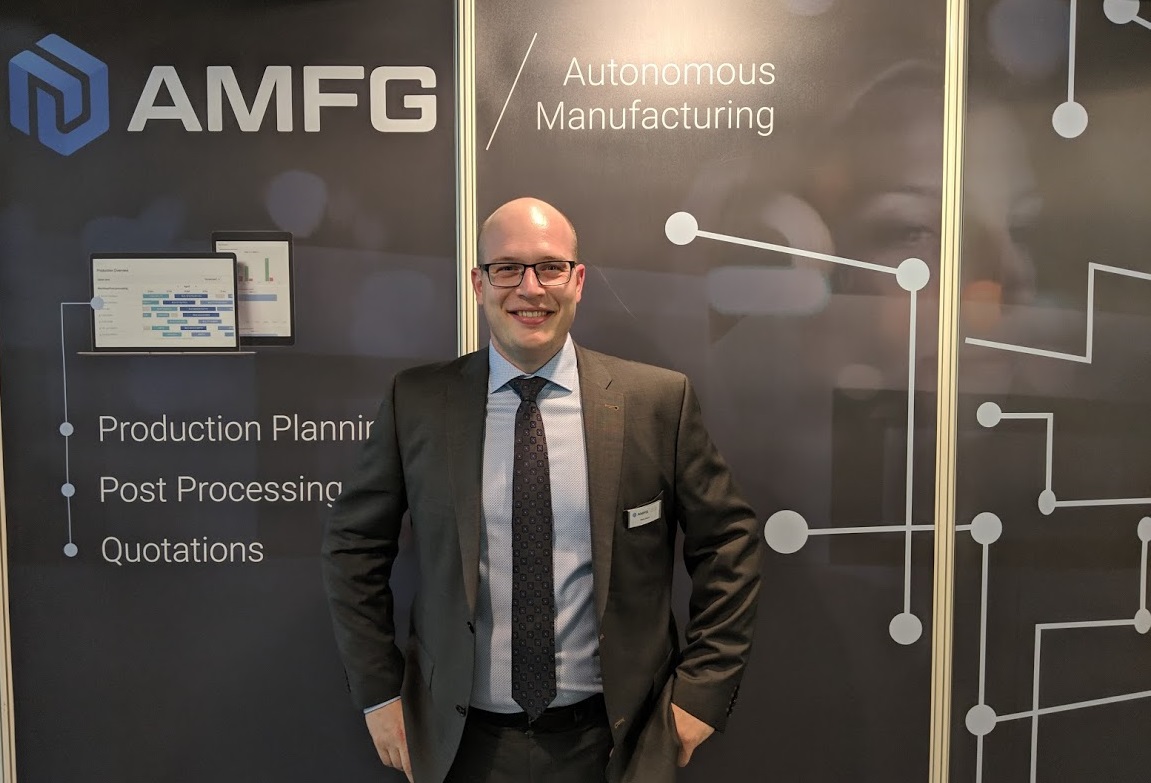![Felix Dörr, Head of Business Development, AMFG, at formnext 2018 [Image: Fabbaloo]](https://fabbaloo.com/wp-content/uploads/2020/05/IMG_20181115_160203_img_5eb0a19665ca7.jpg)
AMFG is so focused on easing the way toward autonomous manufacturing that they named the company for it.
Founded in 2013 as RP Platform, the company rebranded to AMFG (“autonomous manufacturing”) this past June.
“We did the name change because our background is with service bureaus for prototyping. As we’ve gained experience, we have been approached by more manufacturing companies. We’re automating processes — the name wasn’t doing our purpose justice. The name now is also our vision,” Felix Dörr, AMFG’s Head of Business Development, explained when we sat down recently at formnext.
As capabilities have been advancing in 3D printing, the technology has turned from initial focused application in rapid prototyping when “RP” was the common abbreviation to today’s growing usage in “AM” — additive manufacturing. As the terminology grows up with these capabilities, so too does usage among company participants. Manufacturing is increasingly the common underpinning in nomenclature, whether the “A” preceding it is “additive” or “autonomous” — and for AMFG, the name references the latter, with software for the former.
AMFG’s software offerings target industrial 3D printing, with end-use part production a particular focus. Automating more of that process allows for an easier workflow with ultimately better results.
“We want customers in the next 25 years not to have to plan anymore; we want the software to do it,” Dörr said.
With funding from the UK government for an AI project to optimize machine learning, which AMFG’s founder discussed in a session at formnext, the company is “on a good track now” to work toward its goals. AMFG has combined forces with UK universities to implement the project.
“With enough information feedback, we can fully automate not just planning, but conversion, fixing file repairs, how you can automate and optimize post-processing,” Dörr continued. “Integration is a big part of our business. The next thing will be post-processing machines.”
That information exchange is critical for AMFG, which works closely with customers to respond to feedback. When someone says look at this company, Dörr noted, a request to integrate often follows.
“The major thing for us is the move into manufacturing,” he said. “The finished part shows our strength. We offer integration to make it easier to contract; if a company can’t do it themselves, we help. We’re not a marketplace, but we make it easy to connect.”
With end-to-end workflow offerings, AMFG is deeply focused on that concept of integration. Inefficiency remains a challenge as additive manufacturing industrializes, and automating processes will be a key tangible step toward the realization of viable serial production.
The London-based company is focusing its strategies first on the European market, though they also operate in North America and Asia. The team currently comprises 34 in four locations; when Dörr started with AMFG about two years ago, the team was 12 strong, and growth maintains a steady, if deliberate, pacing.
“We’re growing well; not too fast to lose control, but you can see the progress,” he noted. “We’re also hiring in the Lisbon market. The demand is there, so we need more service and support, and technical, people.”
Looking to the overall market, which is trending on the whole toward manufacturing solutions — “serial production” was the phrase of the show this formnext — Dörr is optimistic: competition is good.
“The competition is helping. I haven’t had one conversation of ‘What are you doing?’ Now it’s: ‘How do you solve this problem for this application?’ — and a lot of that is thanks to the competition, as the market is becoming much more educated. I see this as a big benefit, we’re on the shoulders of this industry,” Dörr said.
AMFG’s business model is one that is definitely needed as additive manufacturing continues toward serial production.
The software covers the gamut of the manufacturing process on a single platform — critically with full traceability throughout: requests and communication, auto analysis and repair, part catalog, scheduling automation, machine intelligence, and post-processing control.
Three key words that stick out from the company’s software description, not only vividly in website imagery but because of their importance: repeatable, traceable, automated.
Via AMFG











MiniFactory’s new software produces a very useful report for each 3D print that may be important for clients. We had a close look at one.